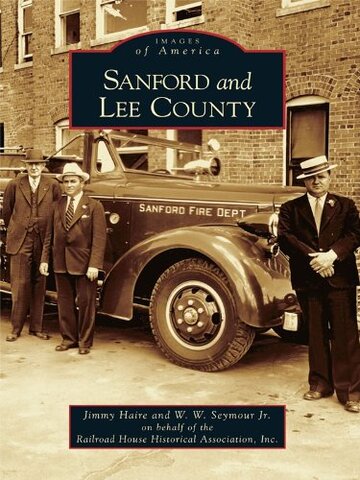Various souvenirs and books can be purchased via cash or check at the museum. Below is just a selection of some of our most popular items.
Christmas Cards
Christmas cards featuring exclusive photographs of the Railroad House and Old Locomotive No. 12 by Sanford native Richard Hayes are now available. Boxes of ten cards with your choice of images are being offered for the sum of $12.00 each. They are available at the Railroad House or from any member of the Board of Directors. All proceeds from the sale of the cards will support the ongoing efforts of the Railroad House Historical Association.
Books and Publications
"Sanford and Lee County" by Jimmy Haire & W.W. Seymour, Jr. |
Book Description:
Located near the geographic center of North Carolina, the Lee County area has been defined by transportation for the past two centuries. From river navigation along the Deep and Cape Fear Rivers to early plank roads, crisscrossing railroad lines, and major U.S. highways, this area has seen countless travelers come and go by boat, car, horse, buggy, train, and motor vehicle. Along the way, a number of the travelers settled, and communities formed. Through the efforts of leaders from communities such as Jonesboro and Sanford, a new county was formed in 1907–1908. Lee County was the 98th county formed in North Carolina, and despite its relatively small land area, it has a rich and vital history. Author Bio: Authors Jimmy Haire and W. W. Seymour Jr. were both born and raised in Sanford and have been friends for more than 40 years. Haire started as a carrier for the Sanford Herald and later became its chief photographer. He currently operates a photography studio in Sanford. Seymour has practiced law in Sanford for more than 30 years. Both have a lifelong interest in the history of Sanford and Lee County and have recently presented a series of local television programs on the history of the area. |
"The Men of Endor" by Robert A. Weisner; Dr. Lynn Veach Sadler, Editor"The development of North Carolina's Deep River coal and iron resources began before the Revolutionary War and halted after it. Renewed efforts in the early 1850's were severely limited by the lack of local markets and transportation to others...
By 1859, a series of dams and locks (from Fayetteville, on the Cape Fear, to Gulf, on Deep River) was completed, permitting steamer transport from Wilmington to Gulf. A railroad, begun at Fayetteville in 1857, was to terminate in the coalfields along Deep River and allow transport of coal to Fayetteville for barging to Wilmington... The stage was set for the mineral development of the Deep River valley and the building of the Endor ironworks when the War Between the States began..." |


